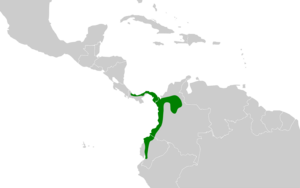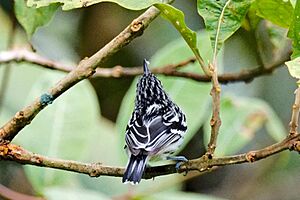Pacific antwren facts for kids
Quick facts for kids Pacific antwren |
|
|---|---|
 |
|
| Conservation status | |
| Scientific classification | |
| Genus: |
Myrmotherula
|
| Species: |
pacifica
|
 |
|
The Pacific antwren (Myrmotherula pacifica) is a small bird found in parts of Central and South America. It lives in Colombia, Ecuador, and Panama. This little bird belongs to a family called "typical antbirds."
Contents
About the Pacific Antwren
How it Got its Name
The Pacific antwren was first described in 1911. An Austrian bird expert named Carl Eduard Hellmayr gave it its scientific name. For a while, people thought it was the same as two other birds, the Guianan streaked antwren and the Amazonian streaked antwren. But scientists later found that their feathers and calls were different. This showed they are actually separate species. The Pacific antwren is a unique species with no known variations or subspecies.
What Does the Pacific Antwren Look Like?
The Pacific antwren is a small bird, about 9 to 10 centimeters (3.5 to 4 inches) long. It weighs around 8.5 to 10 grams (about 0.3 ounces). It has a very short tail.
Male Pacific Antwren
Male Pacific antwrens have a face with black and white stripes. Their head, back, and rump are black with white streaks. They have a small white patch between their shoulders. Their tail is black with white edges and tips. Their wings are black with white tips on some feathers and white edges on others. Their throat, chest, and belly are white. Their sides are a bit grayer. Black streaks run from their throat down to their sides and belly.
Female Pacific Antwren
Female Pacific antwrens look a bit different. Their face, head, and neck are a buff or reddish-brown color. They have black streaks on their head and neck. Unlike males, they do not have a white patch between their shoulders. Their throat and the middle of their belly are a pale buff color. The rest of their underside is an orange-ochre color. Female antwrens do not have streaks on their undersides.
Where the Pacific Antwren Lives
Habitat and Range
The Pacific antwren lives in both the Caribbean and Pacific parts of Panama. It can be found across central Colombia, extending east to the Magdalena Valley. It also lives south along the Pacific coast into western Ecuador.
This bird prefers the lower and middle parts of lowland forests. It also lives in shrubby areas of regrowing forests. You can often find it near rivers and streams. It usually avoids the deep forest, unless there are clearings where new plants are growing. Sometimes, it even appears in gardens and plantations outside the forest.
Elevation
The Pacific antwren usually lives from sea level up to about 800 meters (2,600 feet) high. In Panama, it is found up to 500 meters (1,600 feet). In Colombia, it can sometimes be found as high as 1,200 meters (3,900 feet).
Pacific Antwren Behavior
Movement
Scientists believe that the Pacific antwren stays in the same area all year long. It does not migrate to other places.
Feeding Habits
The Pacific antwren eats small creatures like insects and spiders. It usually hunts alone or in pairs. Sometimes, it might briefly join a group of different bird species that are feeding together.
It mostly looks for food in thick leaves and tangled vines. It often feeds between 2 and 10 meters (6.5 to 33 feet) above the ground. Sometimes, it goes as high as 17 meters (56 feet). It actively searches for prey among leaves and branches. It picks up food by reaching, lunging, or making short flights from a perch.
Reproduction and Life Cycle
The Pacific antwren breeds in Panama between January and July. A nest was seen in Colombia in March.
Nests and Eggs
The nest of a Pacific antwren is shaped like a cup. It is made from small vines and other plant fibers or fine grasses. Sometimes, dry leaves or moss are added to the outside. The nest hangs in a fork of a branch, usually near the end. It is hidden in the leaves, typically between 2 and 6 meters (6.5 to 20 feet) above the ground. A female antwren usually lays two eggs. We don't know how long the eggs take to hatch or how long it takes for the young birds to leave the nest. We also don't know much about how the parents care for their chicks.
Vocalization
The song of the Pacific antwren is a fast, cheerful sound. It rises slightly in pitch, like "chee-chee-chi-chich-ch-ch-ch-ch-ch-ch." Its calls include sounds like "chee-pu," "chee-cher," and a strong, steady "chrreee-chrreee-chrreee-chrreee!"
Conservation Status
The IUCN (International Union for Conservation of Nature) has listed the Pacific antwren as a species of "Least Concern." This means it is not currently in danger of disappearing. It has a large area where it lives. There are at least 50,000 adult birds, though this number is thought to be slowly decreasing. No major threats have been found for this bird.
The Pacific antwren is quite common in its range. It lives in several protected areas. It can live in different types of shrubby forest edges and regrowing habitats. This makes it less sensitive to human activities than many other antbirds.



